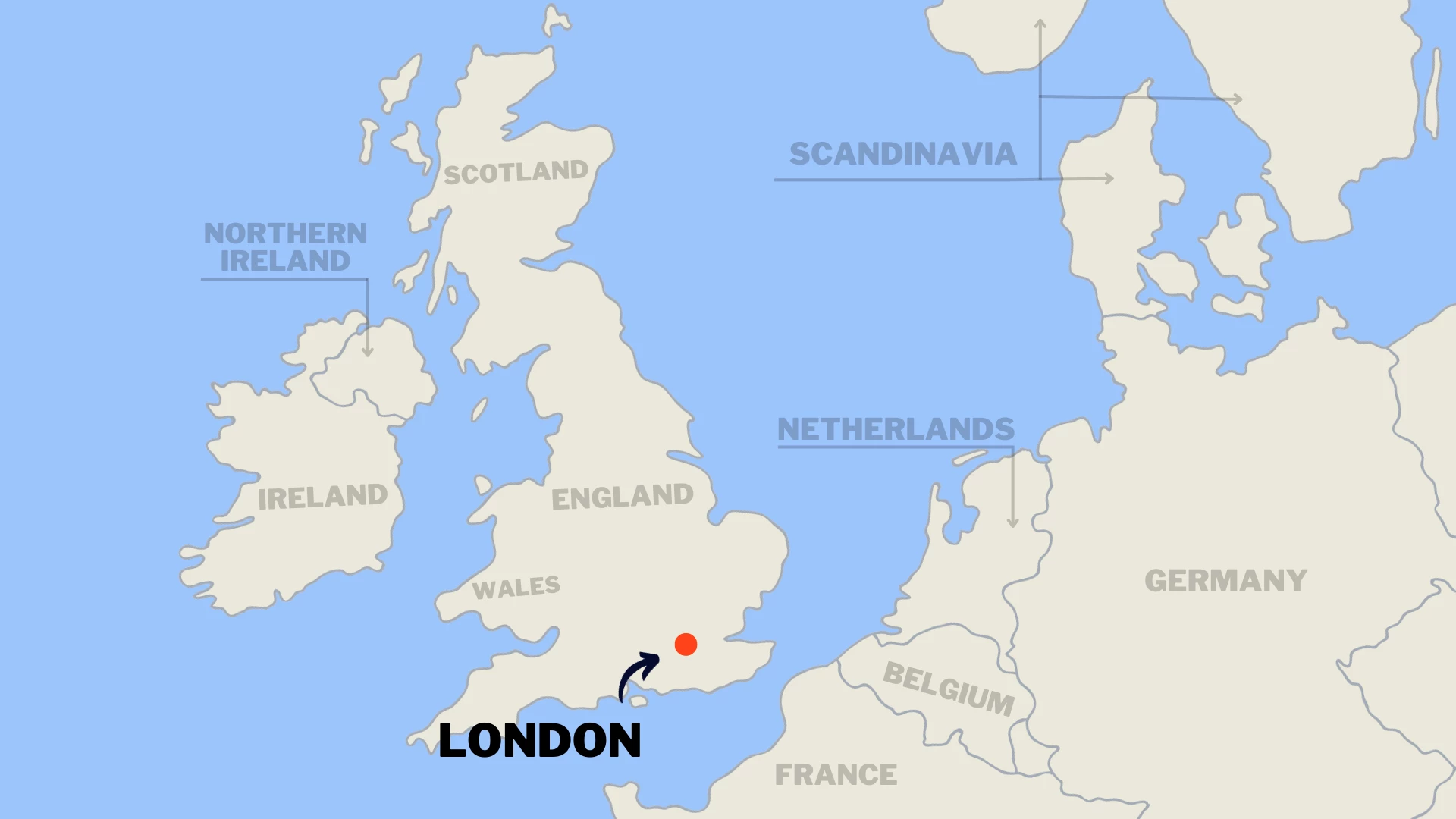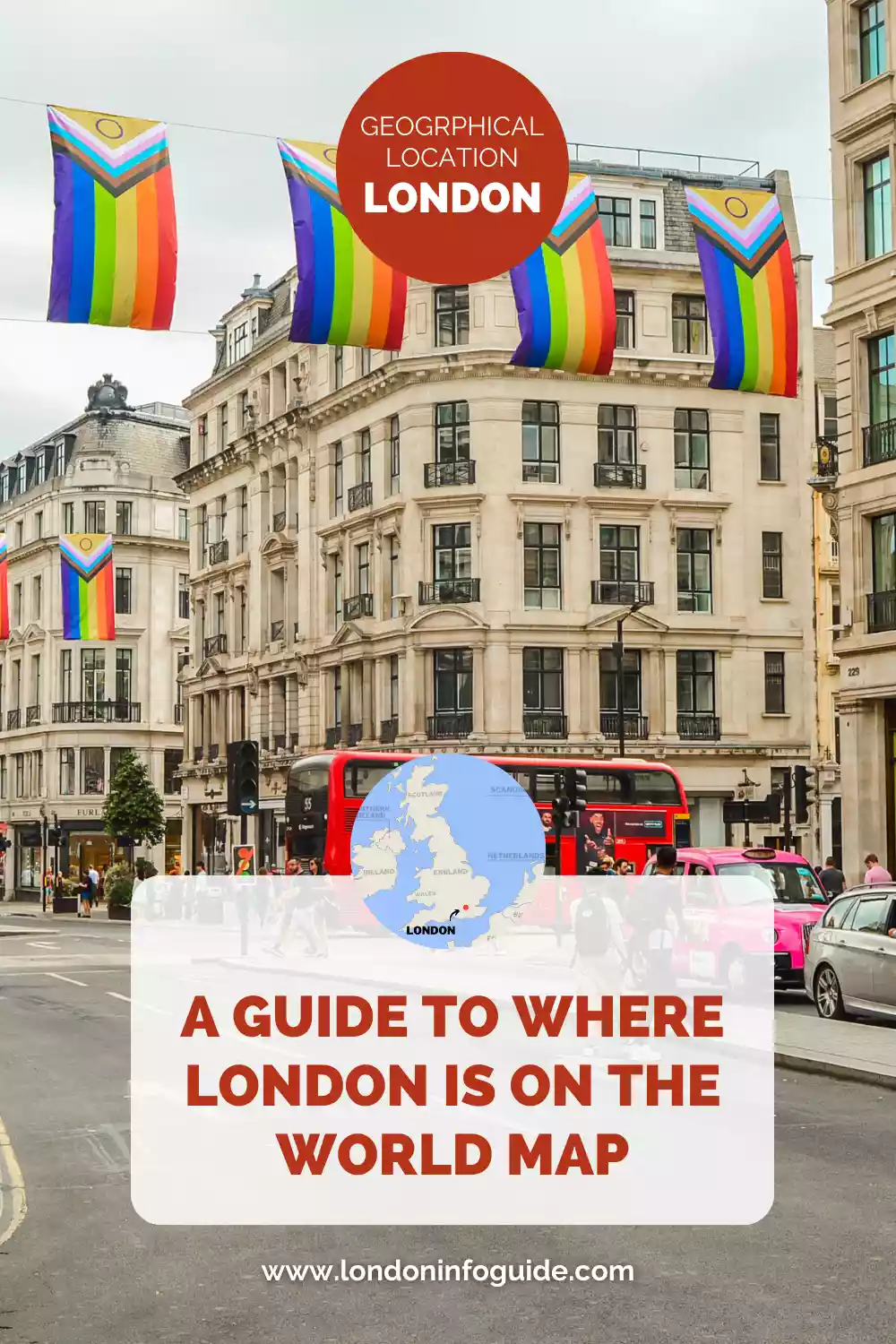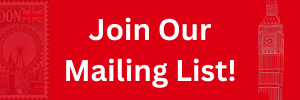- Home
- Where Is London In UK
where is london in uK
The Geographical Guide About London
Where is London in UK? It is a common question that many ask and here you will find the answers to these questions and further information.
The capital city of the United Kingdom is located in the south-east of the country. A major economic, cultural, and political centre, it is Britain's most populous and iconic city. It is situated 70 miles away from the coast of continental Europe in the southern part of England. The River Thames which serves as a significant attraction in London, crosses through the city upstream from its estuary on the North Sea.
🎅 London Christmas Planning 2025 Starts Now!
- 🏨 Best Hotels in London for Christmas
- 🎄 Christmas in London Guide: Events | Lights | Markets | Tours
- ✨ Best Areas to Stay in London
- 🎁 Luxury Hotels in London
- ❄️ Weather In London For Christmas
- 🎟️ Things to Do in London in December
- 🛍️ Shopping in London at Christmas 2025
- 🎡 Visit Winter Wonderland at Hyde Park in London
- 🏨 Best Hotels Close to Winter Wonderland
What You Need To Know About Where is london in UK
- Where is London on the World Map
- How Big is London?
- The Facts about London
- Questions you might ask yourself about the United Kingdom UK
where is london geographically
Geographically, London's coordinates land on the roundabout where Equestrian Statue of Charles l is located exactly in front of Trafalgar Square, City of Westminster Borough London. The coordinates are as follows:
- Latitude: 51.5074
- Longitude: -0.1278
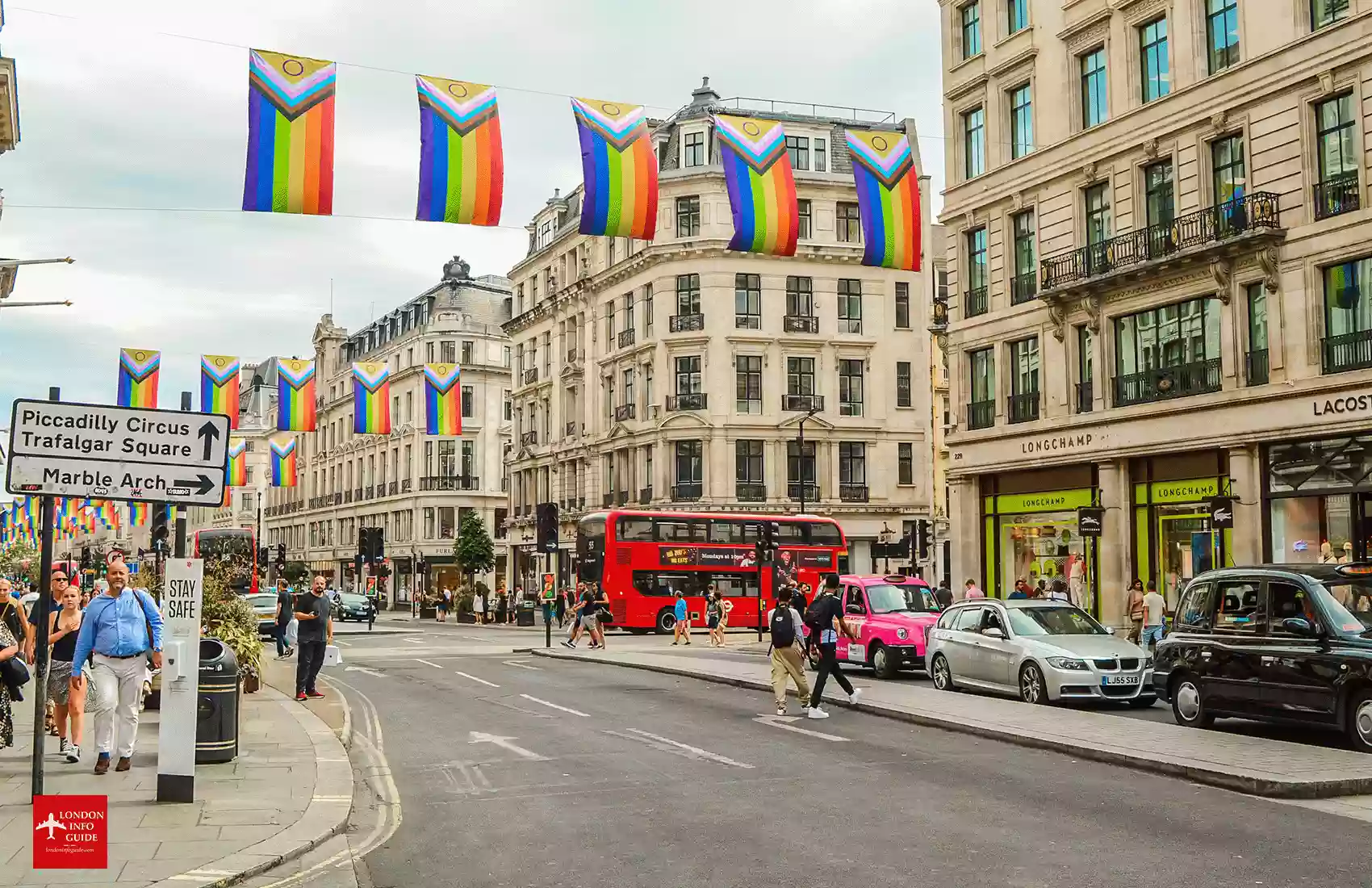 Where Is London In UK - Regent Street London
Where Is London In UK - Regent Street LondonDistance from London to its Constituencies
Based on London's location in the UK, here are the distances from London to the main cities in its three other constituent countries:
- Edinburgh, Scotland: Calculating the shortest distance by Google Maps is 402 miles (647 kilometres) driving by car for around 8 hours. By train from Kings Cross Station London, it will take you around 4 hours 40 min.
- Cardiff, Wales: The shortest distance by Google Maps is 149 miles (240 kilometres) driving by car for around 3 hours 30 min. By train from Paddington Station, it takes around 2 hours.
- Belfast, Northern Ireland: The shortest distance by Google Maps to the west across the Irish Sea is 461 miles (742 kilometres) driving by car for around 10 hours 15 min including the ferry crossing from Holyhead UK to Dublin Ireland. By train from Euston Station to Holyhead a port town in North Wales, to Dublin port and continue by train to Belfast. The duration of the trip is around 13 hours 30 min.
Distance From London To European capitals
London has excellent connections to most major European cities. Due to their proximity to London and ease of access by a variety of ways of transport, these major cities are popular travel destinations for European travellers.
The following distances from London to the major cities are estimated if travelled by car. These are calculated on the shortest route and include the ferry or train across the English Channel. If alternative routes are taken, the distance and time taken will alter accordingly.
- Brussels, Belgium: Roughly 230 miles (370 kilometres) to the east.
- Amsterdam, Netherlands: Approximately 263 miles (423 kilometres) to the northeast.
- Paris, France: About 296 miles (476 kilometres) to the east.
- Dublin, Ireland: While not part of the UK, Dublin is the capital of Ireland and is one of the closest international capital cities to London. It is situated about 361 miles (581 kilometres) to the west of London.
- Rome, Italy: Much further away, around 1,136 miles (1,828 kilometres) to the south.
- Berlin, Germany: Approximately 682 miles (1,097 kilometres) to the northeast.
- Madrid, Spain: A considerable distance to the southwest, about 1,082 miles (1,741 kilometres) from London.
- Vienna, Austria: The most distant of all of these is approximately 953 miles (1,533 kilometres) to the east.
related articles to where is london
- What's the weather like during the year?
- What can I do while on my holiday in London?
- Which area of London is best to stay for my trip?
- Which neighbourhoods of London must I visit and why?
- Is London a great destination worth visiting?
- Visiting London for the first time? Find essential tips and questions.
- How many days should you spend in London? Find our answer here!
- Check out 12 essential things to know before visiting London.
islands around the uK
As a result of their stunning natural surroundings, historical significance, distinctive cultural characteristics, and economic benefits, these islands are popular with families, businesspeople, and nature lovers alike.
- Isle of Skye (Scotland): Stunning landscapes, a hiker's paradise with its breathtaking scenery, the Old Man of Storr, and Fairy Pools.
- Isle of Wight (England): The Needles, Osborne House, and sun-kissed beaches. Recognised for organising the Isle of Wight Festival every year.
- Jersey (Channel Islands): History of St. Helier, a blend of British and French, and nice beaches. Renowned for its offshore banking as well.
- Isle of Man (British Isles): Isle of Man TT, Viking heritage, and picturesque hills. It is recognised as an independent British Crown Dependency.
- Guernsey (Channel Islands): Cobblestone lanes, beautiful towns, and scenic St. Peter Port. renowned for its beautiful harbours and tax advantages.
Where is london on the world map
How big is london?
Going straight to the point, London's geographic size is 607 square miles or 1,572 square kilometres. This covers the entire area of the Greater London region including the City of London as well as the surrounding boroughs and neighbourhoods.
These measurements make London the largest city in both England and the United Kingdom, serving as a major hub of culture, commerce, and politics.
related page: an In-depth guide about the size of london
How Big Is The City Of London?
The City of London is the core area of Greater London. Spanning around 0.7 miles (1.12 kilometres) in length from east to west and about 1.4 miles (2.2 kilometres) from north to south at its widest points. The total surface area is approximately 2.9 square kilometres (1.1 square miles). This city is also referred to as "Square Mile" and even "the City". There is a distinctive difference in size between the City of London and Greater London.
Note that when people refer to 'London' they are not referring to the City of London but to the Greater London area.
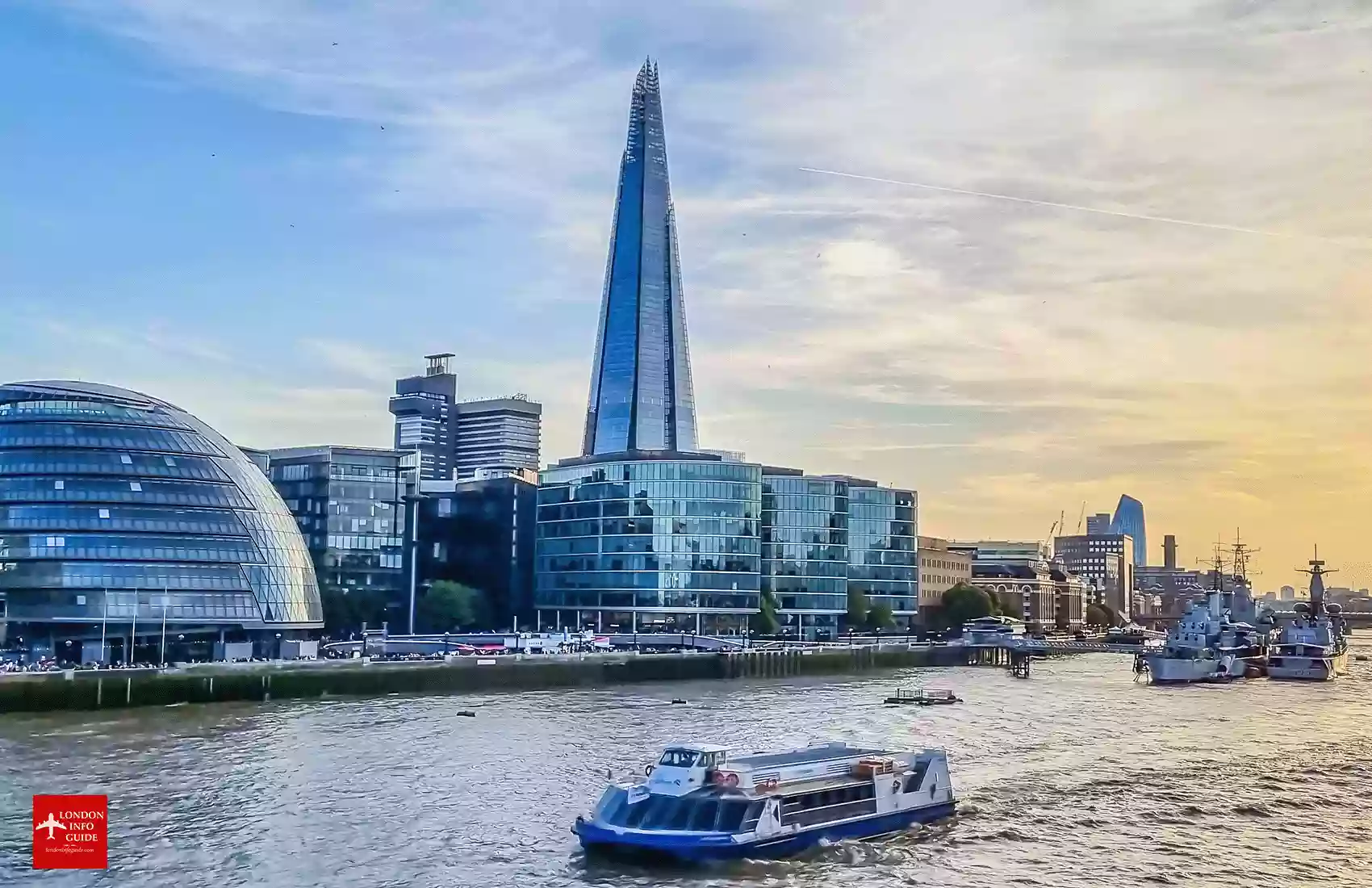 The Shard - Southwark London
The Shard - Southwark Londoninteresting facts about london england
Below we have listed down a number of facts about London which are categorised in different sections, namely general, interesting and historical.
General facts about London
Time Zone: Great Britain has set its clock at Greenwich Mean Time (GMT) for the winter months and with daylight saving time (GMT+1) for the summer months.
Five airports in London: London Heathrow Airport, London Gatwick Airport, London Stansted Airport, London Luton Airport, and London City Airport.
Population of Greater London: *Statistics show that 8.797 million people were living in London in mid-2021.
Official Language: English is spoken across the UK.
Currency: In the UK the British Pound Sterling (£). Check out our in depth guide about Currency in London.
Electricity Supply: 230 volts AC (50Hz). If you are travelling to the UK you need UK electrical outlets which are Type G.
Measurements: The metric system is officially used for most purposes.
Emergency Number: 999 or 112 both used for police, fire and medical emergencies.
Area code or city code: To dial London 20. The international code is 44. Example of a telephone number 44 20X XXX XXXX.
best tours from london england
Other interesting facts on london
World-renowned museums: Such as the British Museum, the National Gallery and the History Museum.
Traffic: In London, cars are driven on the left side of the road. This applies to all UK constituents namely England, Scotland, Wales and Northern Ireland.
UK Parliament: It is the supreme legislative body of the United Kingdom. It consists of two main houses: the House of Commons and the House of Lords.
Cultural Diversity: London is home to people from many ethnicities, languages, and cultures. As a result of this, the city's cuisine, arts, and festivals are influenced by the world.
Tourism: London is one of the world's most popular tourist destinations, drawing millions of visitors each year.
Four UNESCO World Heritage Sites: The area comprises the Palace of Westminster (the Houses of Parliament), Westminster Abbey, and the Church of Saint Margaret. The Tower of London, Maritime Greenwich and last the Royal Botanic Gardens at Kew.
Brexit: The UK's exit from the European Union, officially ended its membership on January 31, 2020.
Read Further: Find out how to get around London
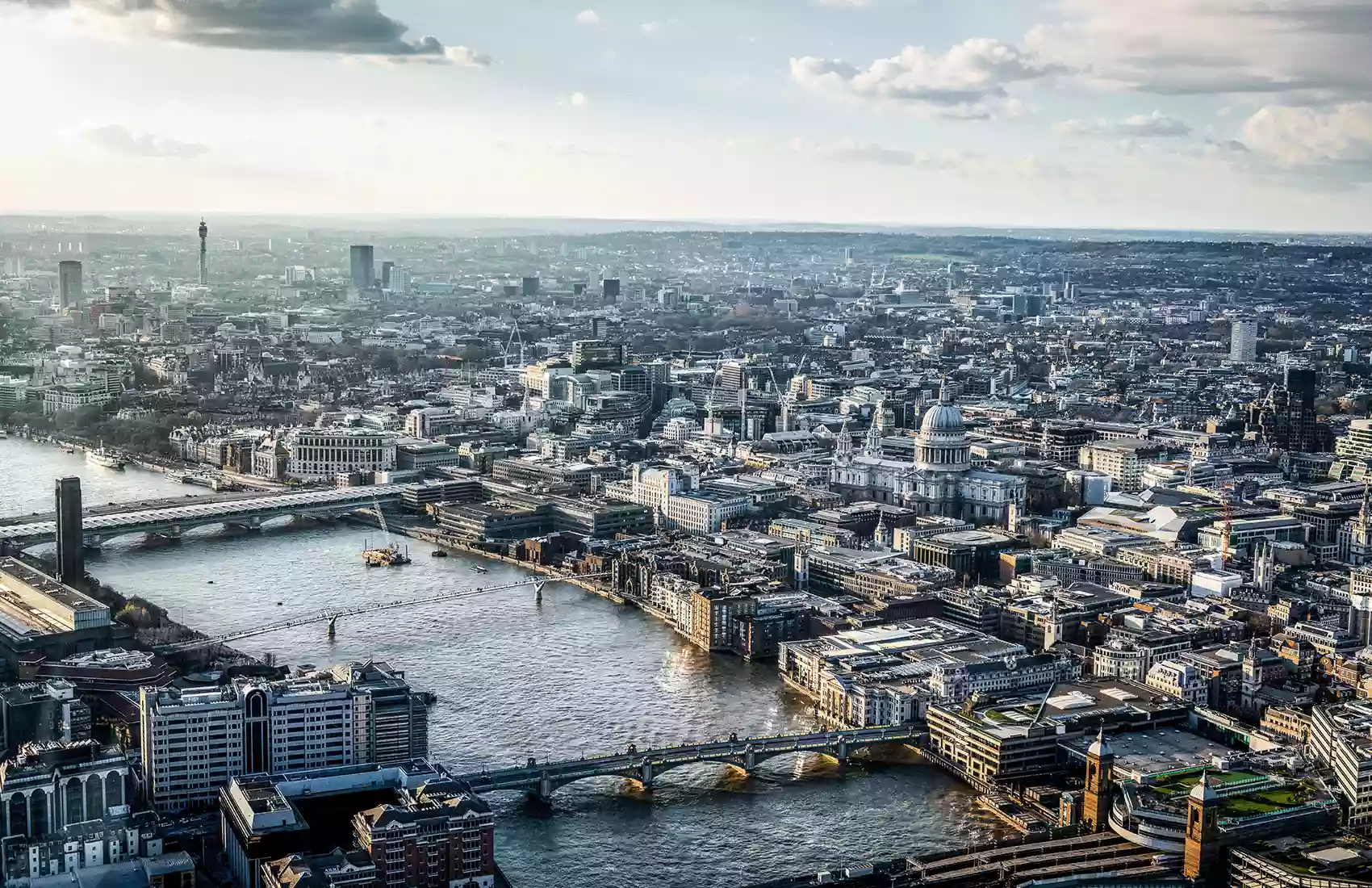 Bird's Eye View of London
Bird's Eye View of Londonfacts about the history of london
AD 43: The Roman founding of Londinium marked the beginning of London's storied history and revealed centuries of cultural and historical development.
Influential: Throughout its history, London has been a major cultural, economic, and political centre.
Rulers: It was ruled by various groups, including the Romans, Anglo-Saxons, Vikings, Normans, and Tudors, leaving an indelible mark on its architecture and culture.
World War: During both World War l and World War ll, London saw heavy bombing and air raids on the city.
Capital City: London is the capital of the United Kingdom, a parliamentary constitutional monarchy.
Cosmopolitan: The city's neighbourhoods and food reflect its diverse cultures. Furthermore, it is an important international financial centre.
The people of london
The people of London, known as Londoners, comprise a diverse and multicultural population hailing from various parts of the world, reflecting the city's cosmopolitan character.
Londoners predominantly speak English, and the city is recognised as one of the most linguistically diverse places on the planet where there are over 300 languages spoken in the city alone.
It is the reputation of Londoners to be polite and to queue (wait in line). It's generally not a good idea to cut in line while queuing.
How Many Days In London
There is so much to discover in London and its endless wonders can make getting to know it a challenge! Are you unsure how many days you will need? To ensure you make the most of your time exploring this dynamic city, we've developed multiple itineraries for your planning.
1 Day | 2 Days | 3 Days | 4 Days | 5 Days | 6 Days | 7 Days | 10 Days | 4 Day Christmas Itinerary | Trip To London in December
While exploring the geographical location of Greater London we have also uncovered some fascinating details of London and the United Kingdom. Whether you are just a local or a tourist planning to visit London soon, this guide will help you understand where the Greater London area sits on the world map.
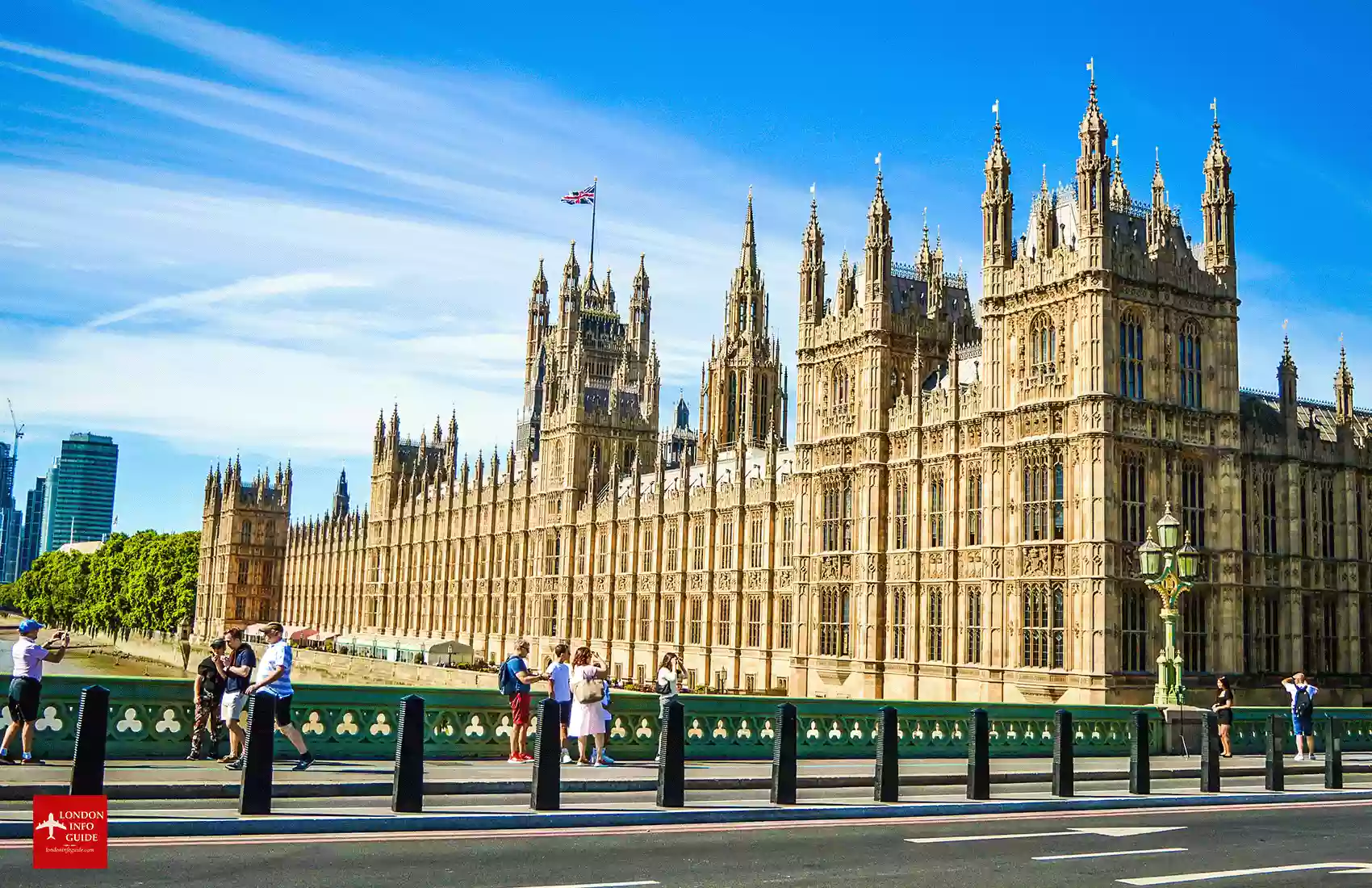 Palace of Westminster - Houses of Parliament
Palace of Westminster - Houses of ParliamentFAQs about where is london in uK
Where is the City of London?
Where is the City of London?
The City of London is a part of Greater London and is often called simply "the City". It is a historically significant financial district that is home to the Bank of England, the Stock Exchange, several contemporary business skyscrapers and historical landmarks.
Where is London on the map?
Where is London on the map?
London, a city situated in the southeast region of England, is the capital of the United Kingdom. Located along the southeast coast of the nation, it is close to the River Thames. According to a map, the central region of London can be found at 51.5074° N latitude and 0.1278° W longitude.
Where is Paris and London?
Where is Paris and London?
The capitals of France and the United Kingdom are Paris and London. Both cities are divided into several areas. 32 boroughs in London and 20 "arrondissements" in Paris. Each city is around 292 miles apart from each other including a crossing over the English Channel.
Well-known landmarks and fulfilling experiences make both fantastic vacation destinations.
Is London in the UK?
Is London in the UK?
There are four constituent countries (England, Scotland, Wales and Northern Ireland) that make up the United Kingdom (UK), the capital and largest city is London.
Is London a country?
Is London a country?
No, London is not a country. It is the capital city of the United Kingdom (UK) and is located in England.
Where is New London?
Where is New London?
In the colonial era, English emigrants named towns after locations in England to preserve a connection to their homeland, leading to many "New London" locations across the United States of America.
Is London a city?
Is London a city?
Indeed, London, UK, serves as both the nation's capital and a city.
Where is London located in the UK?
Where is London located in the UK?
It is situated in the south-eastern region of England along the river Thames.
Find The Best Places To Stay Nearby
This fantastic interactive map below helps you discover the best accommodation across London from a variety of trusted platforms. Explore different neighbourhoods, compare prices, and book directly all under one platform.
Want To Share This Page On Pinterest? Pin It Here!
Photo sources & Resources - where is london in uK
- Aerial View of London - Photo by Andres Garcia on Unsplash
Resources
